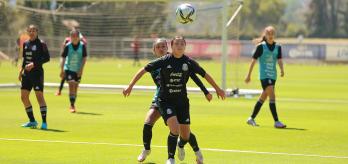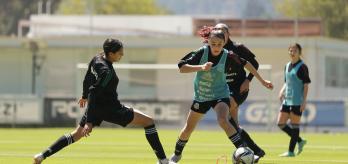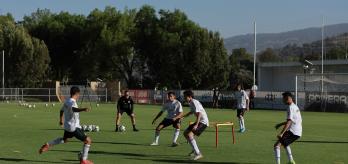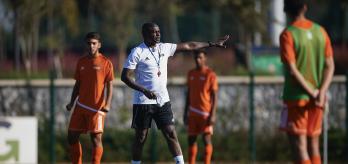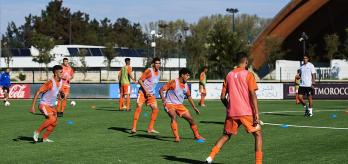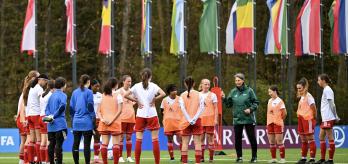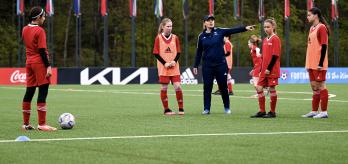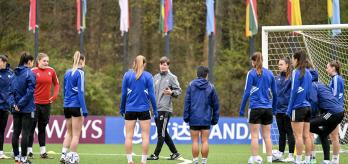Another key benefit of applying a defensive press is that it helps to prevent the opposition from playing forward passes through the thirds. Understanding when the first pressing player should close down the receiving player, which must be coordinated with the timing of the second and third pressing players, is crucial to form a compact pressing unit. If these principles can be understood and applied at a young age, players will be able to easily adopt this approach by the time they reach senior football, in which it is a fundamental element of the game.
In this session, FIFA Women’s Football Technical Expert Belinda Wilson introduces the fundamentals of pressing to prevent forward passes. The session starts with a warm-up that focuses on how players go about preventing forward passes and leads into a positioning exercise. The session is rounded off with two 8v8 games – one coached and one uncoached – in which the players are asked to put the principles worked on in the previous exercises into practice.
Session overview
Key coaching points
-
Pressing players should arrive on the receiving player’s first touch and get touch-tight to prevent them from turning and playing out.
-
Players providing cover should shut off passing lanes into other opposition players and join the press as soon as the ball starts to travel towards the receiving player.
-
Pressing players should recognise which players are closest to the ball and close down the opposition immediately.
-
The second and third pressing players must be aware of their interchanging roles within the press. The second pressing player provides cover and then becomes the first pressing player if the ball is played past the first pressing player.
-
Focus on the direction of the press to allow the pressing team to force the opposition’s play away from the dangerous areas they seek to work the ball into.
Introduction
To get the session under way, gather the players together and present them with a visual representation of how to prevent the opposition from playing forward and to press as a unit. Set out cones that represent the two sets of players and explain and discuss how the pressing team go about preventing the opposition from progressing play.
Use a step-by-step approach to explain to the players how to press as a unit, with the aim being for them to then apply this theory in the session.
Part 1: warm-up, rondo in a reduced-sized playing area
The warm-up focuses on how out-of-possession players should press to prevent the opposition from playing forward. The pressing team will have more success in shutting off forward passes when the player closest to the ball initiates the press and the next pressing players immediately join the press.
-
Mark out two 15x15m playing areas.
-
Position 5 orange players and 3 blue players in each playing area.
-
Place one ball in each playing area.
-
The blues aim to retain possession. If they complete ten passes, they are awarded a goal.
-
The oranges try to prevent the blues from playing forward by making interceptions or forcing the ball out of play. If they succeed in doing so, they are awarded one goal.
-
Rotate the players after a couple of minutes so that they all have the opportunity to defend and attack.
-
The defending player closest to the in-possession player must close the ball down quickly and try to block off the passing lanes.
-
The second pressing player must provide cover for the first pressing player and try to block off any passes that get past their team-mate.
-
Players must constantly switch roles within the press. For example, if the ball gets past the first pressing player, the second pressing player now becomes the first pressing player and the player who initiated the press becomes the “cover” player.
-
The third pressing player should provide cover for the second pressing player while also anticipating passes to make an interception.
-
The ability to quickly recognise forward passing lanes improves the defending team’s chances of regaining possession.
Part 2: positioning game
This first exercise is designed to help players to recognise when to initiate the press during the opposition’s build-up. The first pressing player’s timing, which must be coordinated with that of the second and third pressing players, is crucial when it comes to preventing the opposition from playing forward.
-
Mark out two 30x20m playing areas inside one half of the pitch.
-
Set up a 4v4 (plus a goalkeeper) in each playing area.
-
Divide each playing area into equally sized halves.
-
Position the goalkeeper on the end line of the top half of the playing area.
-
Set up a 3v3 in the top half of each playing area.
-
Arrange a 1v1 in the other half.
-
Play starts with the goalkeeper playing the ball to an orange player.
-
The blues aim to transfer the ball to their team-mate positioned in the opposite half.
-
The blues try to prevent the oranges from playing forward and look to regain possession.
-
If the oranges win possession, they must play the ball to the goalkeeper or their team-mate stationed in the opposite half to be awarded a goal.
-
When a team score a goal by transferring the ball into the other half, play continues in that half with the team that scored.
-
The closest defender to the ball initiates the press and must get touch-tight to the in-possession player.
-
Players should adopt a side-on body shape when pressing, as this forces the opposition to play passes into congested areas.
-
To prevent receiving players who receive the ball with their back to play from turning, pressing players should reach them before they have even taken a touch.
-
When the goalkeeper is in possession, the attacking team should try to make the playing area bigger by using the full width and depth of the playing area.
-
The defending team should try to counter this by making the pitch smaller and aim to arrive on the receiving player’s first touch.
Part 3: 8v8 coached game
This 8v8 game works on giving the pressing team the platform and structure to press as a unit. By working in an organised structure, it is easier for players to identify when it is their turn to press and allows the second and third pressing players to adapt to the movement around them and press more quickly.
-
Mark out a 70x30m pitch.
-
Place a full-size goal at each end of the pitch.
-
Position a goalkeeper in each goal.
-
Divide the group into two teams of 8, plus goalkeepers.
-
Set both teams up in a 4-3-1 formation.
-
Play starts with the blues’ goalkeeper.
-
The blues try to build up from the back and score in the opposing goal.
-
The oranges must defend on the front foot and prevent the blues from playing forward.
-
If the oranges succeed in regaining possession, they can try to score into the opposing goal.
-
If the oranges fail to score or the blues turn over possession, play restarts with the blues’ goalkeeper.
-
Switch the teams so that all of the players have the opportunity to attack and defend.
-
Organise the pressing team into a three-line structure to encourage players to press and operate as a unit.
-
Emphasise the importance that pressing players reach the receiving player on their first touch, which increases their chances of regaining possession.
-
After winning the ball back, encourage players to gain control of the ball first before looking to score, as rushed actions may result in possession being turned over again.
-
Force opposition errors by cutting off passing lanes using the cover players (second, third, fourth pressing players) and force the opposition to play in areas that are difficult to play out of.
-
The pressing team can increase their chances of recovering possession by making the pitch smaller and staying compact.
-
Pressing players should move towards the receiving player as soon as the ball leaves the passer’s foot to allow them to be touch-tight and prevent the receiving player from being able to turn into space.
Part 4: 8v8 uncoached game
The final drill involves an unrestricted 8v8 game that aims to give the players the chance to put all of the pressing principles that they have worked on throughout the session into practice. The players should now understand how to press as a coordinated unit and which player’s turn it is to press.
-
Mark out a 70x30m pitch.
-
Position a full-size goal at each end of the pitch.
-
Place a goalkeeper in each goal.
-
Divide the group into two teams of 8, plus goalkeepers.
-
Implement standard football rules.
-
Both teams try to build an attack and score into the opposing goal.
-
The out-of-possession team apply a high press and try to win the ball back.
-
If a team win the ball high up the pitch, they must try to score as quickly as possible.
-
Play seven-minute halves.
-
The defending team should make the pitch small by maintaining a compact structure, which helps players to press more effectively.
-
When the in-possession team are forced to play backwards, use the goalkeeper to open up the pitch and create passing lanes.
-
As the ball is travelling, pressing players must look to get touch-tight and reach the receiving player before they have taken a touch.
-
As part of the philosophy to let the players play, the coach should only offer the players encouragement rather than stopping play and intervening.








